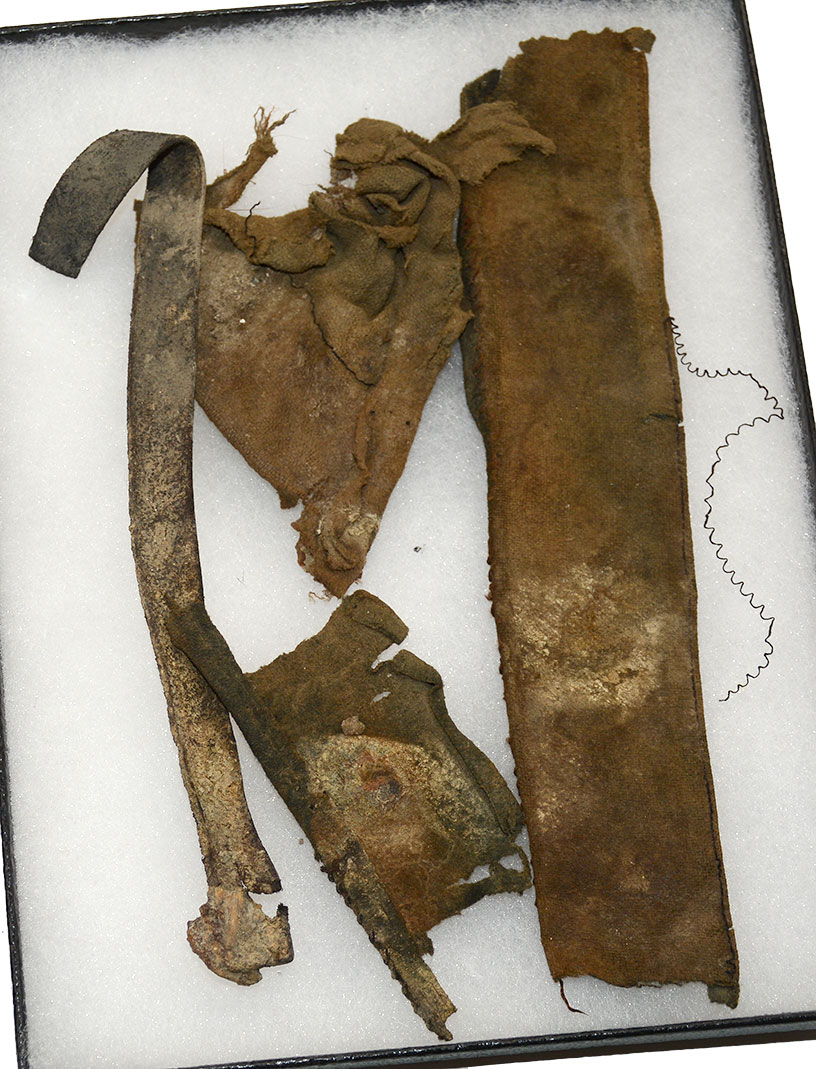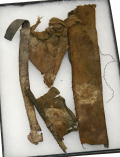site search
online catalog
CIVIL WAR / INDIAN WAR US ARMY CAP FRAGMENTS FROM FORT PEMBINA, NORTH DAKOTA

$35.00 SOLD
Quantity Available: None
Item Code: 1052-436
These pieces of an army kepi were excavated at Fort Pembina, ND, a small frontier post in operation from 1870 to 1895. The dig produced cloth and leather gear in varied condition showing the typical postwar army mix of Civil War issue material being used well into the 1870s, along with later army experimental and issue patterns, and private purchase, commercial material. These pieces are pretty clearly from a kepi and include part of the wide band that would run around the base of the cap and part of a leather strip that would be used as a stiffener between that lower cloth band of the body of the cap and the sweatband sewn inside. The other pieces with it are from the same cap. All show the same color shift from blue to an olive brown, with some white and gray stains.
The wide band indicates the cap was a kepi, likely an issue or commercial version of the Model 1872, rather short and with an inset top, descended from the low crown chasseur style kepi that became popular among officers later in the Civil War and was considerably nattier than the Civil War issue forage cap.
Fort Pembina, situated in the Red River Valley in North Dakota near the Canadian border, was established in 1870 and in operation until 1895. Trading posts existed earlier in the area as part of the fur trade, and the first U.S. military post there was temporary- manned by a detachment of Minnesota troops in 1863-1864 following the 1862 Sioux uprising. In March 1870 a new fort was established south of the Pembina River and about 200 yards west of the Red River, completed by July and named in honor of Gen. George H. Thomas. The name was changed to Fort Pembina in September and the initial garrison consisted of two companies of the 20th US Infantry. Their main purpose was to provide security for settlers worried about Sioux returning south from Canada, but the troops spent much of their time escorting boundary surveys along the Canadian border and preventing Fenian raids heading north into Canada.
The fort included enlistedmen’s barracks, officers’ quarters, guard house, ordnance storehouse, company kitchen, root house, laundress’s quarters, quarters for civilian employees, hospital and hospital servant’s house, a barn for the “hospital cow,” quartermaster and commissary offices and storehouse, stables, wagon shed, etc. The garrison reached peak strength in 1878 af 200, but the average was about 125 enlisted men and 8 officers. An October 1885 return listed 97 men, 2 field pieces, 1 mountain howitzer, 100 rifles, 19 pistols, 23 mules, and 9 wagons. By 1890 the post had just 23 men, and after an 1895 fire destroyed some 19 buildings it was decided to abandon the fort rather than rebuild, the last detachment left in September. The property was turned over to the Interior Department and later sold in 1902.
These are neat relics actually from a small frontier US Army Indian War fort, excavated on private property with the owner’s permission. [sr][ph:L]
~~~~~~~~~~~~~~~~~~~~~~~~~~~~~~~~~~~
THIS ITEM, AS WITH ALL OTHER ITEMS AVAILABLE ON OUR WEB SITE,
MAY BE PURCHASED THROUGH OUR LAYAWAY PROGRAM.
CLICK HERE FOR OUR POLICIES AND TERMS.
THANK YOU!
Inquire About CIVIL WAR / INDIAN WAR US ARMY CAP FRAGMENTS FROM FORT PEMBINA, NORTH DAKOTA
For inquiries, please email us at [email protected]
Most Popular
Historical Firearms Stolen From The National Civil War Museum In Harrisburg, Pa »
Theft From Gravesite Of Gen. John Reynolds »
Cavalry Carbine Sling Swivel »
Fine Condition Brass Infantry Bugle Insignia »
featured item
LARGE GROUP OF ITEMS FROM OHIO’S BRIGADIER GENERAL ABRAM PIATT – COMMANDER OF THE PIATT ZOUAVES
Abram S. Piatt was born in Cincinnati, Ohio, May 2, 1821. He was educated at the Athenaeum and at Kinmount Academy in Cincinnati, and then engaged in farming in the Macacheek Valley. He began to study law in 1846, and in that year founded a… (1179-178). Learn More »



